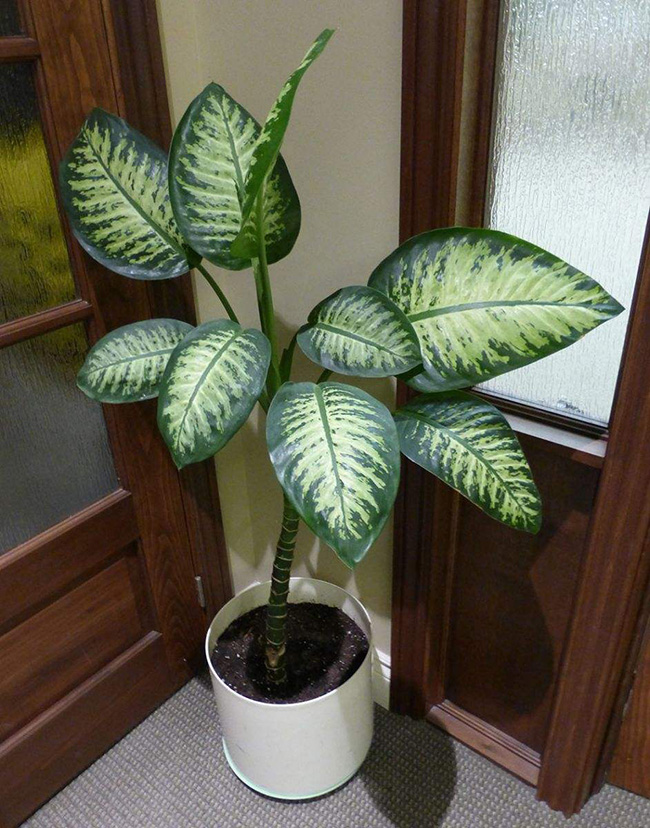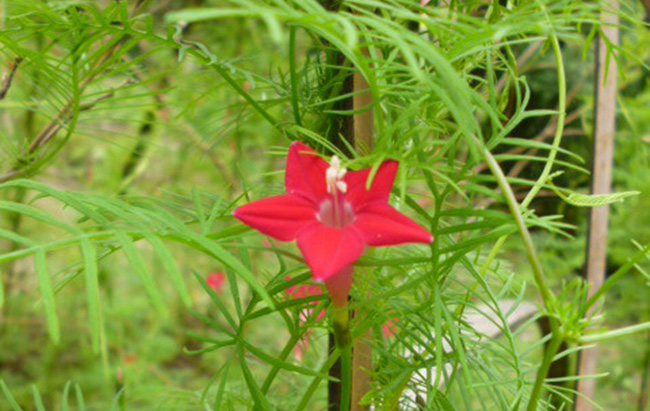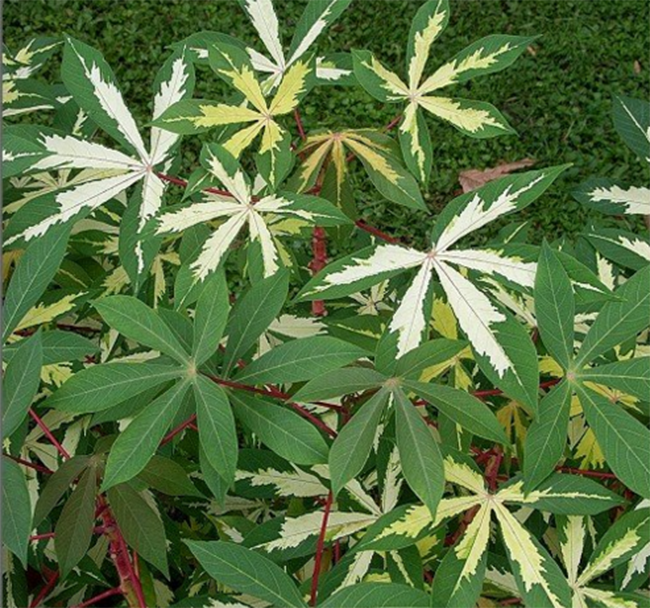Culture methods and matters needing attention of Dawangdai powder leaves
Wang Dai Fan Ye Encyclopedia
Daifen leaf (Dieffenbachia amoena), also known as Dawang evergreen, giant evergreen, Araceae, Daifen (evergreen), is native to tropical regions of Brazil, Central and South America.
Morphological characteristics of Wangdai Powder Leaf
Perennial evergreen herbs. Stem stout, erect, to 2 m high. When potted, the plant height is about 1 meter. The leaf blade is large, long oval, dark green and shiny, with milky white stripes and spots along both sides of the midrib.
The commonly cultivated summer white powder leaf is an excellent cultivated variety of Dawangdai powder leaf.

Growing environment of Dawangdai powder leaves
Sexual preference for high temperature, high humidity and semi-overcast environment. Not resistant to cold, the lowest temperature in winter should be kept above 15 ℃. Loose, fertile and well drained soil is required.
Distribution range of Dawangdai powder leaves
Native to tropical regions of Brazil, Central America and South America.
Propagation method of Dawangdai Powder Leaf
Cuttings are often used for propagation. The cuttage is usually carried out from April to June. The apical stem is about 10 cm long as cuttings, the lower leaves are cut off, the cut is coated with a mixture of charcoal soil and sand, and placed in a shaded place to maintain the temperature of 21-24 ℃. Rooting begins about half a month after cutting, and it can be pots after a month.
Cultivation techniques of Dawangdai Powder leaves
Wang Dai powder leaves have strong negative tolerance and like soft scattered light. The summer season should be placed in a sparse shade to avoid direct glare. Otherwise, the surface of the leaf will become rough, the color will not be coordinated, the gloss will decrease, and even scorched leaves will appear. It should be properly illuminated in winter and usually placed in a place with sufficient light. If the light is too dark, it will also cause the leaves to fade and affect the viewing.
The leaves of Dawangdai powder are not resistant to cold, and the optimum temperature for growth is 20: 30 ℃. The room temperature should be kept above 15 ℃ in winter and stop growing when the temperature is less than 13 ℃. When the temperature drops to 6: 8 ℃, it will be damaged by cold and cause fallen leaves. If in a moderate temperature environment, plants can grow all the year round.
Dawangdai powder leaves have larger leaves and faster water transpiration, so they need more water during the growth period, so they should be watered adequately in the growing season. If the basin soil is too dry, it will lead to poor growth of stems and leaves, and even dry up and die. However, it should not be watered too much, and the basin soil is too wet for a long time, which can easily cause the root system to blacken and rot. The most suitable air humidity is 80% to 90%. In dry weather and summer, you should often spray water on the leaves and on the ground around the flowerpot. Watering in winter should be properly controlled to keep the basin soil dry, but the leaves still need to be sprayed with warm water to keep the leaves beautiful and clean.
Dawangdai powder leaves are more resistant to fertilizer, so more fertilizer should be applied during the peak growing season. However, if there is too much fertilization, especially when the nitrogen fertilizer is too much and the phosphate fertilizer is insufficient, the color lines on the leaves will fade, and the green part will increase, which will affect the outlook. For young plants, thin liquid fertilizer mainly based on nitrogen fertilizer can be applied twice a month to promote their rapid growth and early formation; for formed plants, in order to maintain their good plant type, fertilizer should be controlled so as not to grow too large. usually apply compound fertilizer once a month. In the peak growing season, 0.2% potassium dihydrogen phosphate solution can be sprayed twice to make the leaves fresh and bright. Fertilization should be stopped during overwintering.
Dawangdai powder leaves grow faster, and the larger basin should be replaced once every spring. The basin soil can be made of peat soil plus garden soil, and then a small amount of long-acting particles can be used as base fertilizer. The base of the stem of the old plant is often easy to peel off the smooth stem, so it is best to renew every 2 ~ 3 years to promote the re-germination of new leaves. Generally change the basin from April to May, be careful not to touch the plant, lest the sap of its leaves and stems come into contact with the skin and cause accidental injury.
Wang Dai powder leaf diseases and insect pests
If it is not well managed and vulnerable to aphids and shell insects, it should be prevented as soon as possible.
Culture method of Dawangdai Powder Leaf
Wangdai powder leaves have a short dormancy period when the summer temperature is high, when the plant growth is slow or completely stagnant, it can be maintained in a well-ventilated place to avoid long-term rain, and slightly shaded, controlled watering, and do not apply fertilizer.
Spring, autumn and early summer are the main growing periods of the plant, which should be given sufficient sunlight. Although it can grow in the semi-shade, it will become dark green near the growing point, and the dark purple of the leaves in other parts will also become light brown, affecting ornamental.
In addition, excessive nitrogen fertilizer in the soil and overgrowth of plants will also cause this phenomenon. Therefore, usually make the pot soil a little drier, let the plant grow a little slower but will get a better effect. In winter, if the lowest temperature is not less than 10 ℃, it can be watered normally to make the plant continue to grow, but there is no need to apply fertilizer; if it can not maintain such a high temperature, control watering, make the plant dormant, can also withstand the low temperature of 3-5 ℃.
When the basin is changed every 1-2 years, the basin soil is required to be fertile and has good drainage. 2 parts of coarse sand or vermiculite, 1 part of rotten leaf soil and 1 part of garden soil are often used after mixing. If an appropriate amount of plant ash or bone powder is added as base fertilizer, the effect is better. Relatively speaking, Wang Dai powder leaves grow stronger, and the management can be a little more extensive.
The Culture method of Dawangdai Powder Leaf
Wangdai powder leaves have a short dormancy period when the summer temperature is high, when the plant growth is slow or completely stagnant, it can be maintained in a well-ventilated place to avoid long-term rain, and slightly shaded, controlled watering, and do not apply fertilizer.
Spring, autumn and early summer are the main growing periods of the plant, which should be given sufficient sunlight. Although it can grow in the semi-shade, it will become dark green near the growing point, and the dark purple of the leaves in other parts will also become light brown, affecting ornamental.
In addition, excessive nitrogen fertilizer in the soil and overgrowth of plants will also cause this phenomenon. Therefore, usually make the pot soil a little drier, let the plant grow a little slower but will get a better effect. In winter, if the lowest temperature is not less than 10 ℃, it can be watered normally to make the plant continue to grow, but there is no need to apply fertilizer; if it can not maintain such a high temperature, control watering, make the plant dormant, can also withstand the low temperature of 3-5 ℃.
When the basin is changed every 1-2 years, the basin soil is required to be fertile and has good drainage. 2 parts of coarse sand or vermiculite, 1 part of rotten leaf soil and 1 part of garden soil are often used after mixing. If an appropriate amount of plant ash or bone powder is added as base fertilizer, the effect is better. Relatively speaking, Wang Dai powder leaves grow stronger, and the management can be a little more extensive.
The curing method of Wang Dai Powder Leaf the efficacy and function of Wang Dai powder leaf
Wang Dai Fen Ye, also known as Da Ye Wan Chuqing, is a kind of endemic plant native to tropical South America. Let's take a look at the maintenance methods and the efficacy and function of Da Wang Dai Fen Ye.
Maintenance methods of Wang Dai powder leaves:
After buying Dawangdai powder leaf, because its leaf is large and easy to be damaged, attention should be paid to protection in transportation. if the temperature and humidity are too high for a long time, the leaf will rot, so it should be properly ventilated during transportation. and can be wrapped with newspapers or plastic bags.
Dawangdai powder leaves like warm, humid and semi-overcast environment, suitable temperature for growth is 25-30 ℃, overwintering temperature is more than 10 ℃, like scattered light, avoid strong light. Dawangdai powder leaves are rich in humus and well-drained soil. if pots need to be changed during breeding, the basin soil can be prepared with humus leaf soil, garden soil and river sand at 2:1:2, plus rotten barnyard manure, bone meal or cake manure.
In the growing season of Wang Dai powder leaves, water is watered every 1-2 days, so that it is better to be wet than dry. At this time, in order to make the markings of Wang Dai powder leaves more obvious, the leaves are bright, 1-2 times a month can be applied to nitrogen-based 1% compound fertilizer or cake fertilizer water. When the temperature is higher than 25 ℃, in addition to properly increasing the amount of water, it is also necessary to spray water on the leaf surface. The weather turns cool after autumn, the water should be properly controlled to make it dry and wet, and in winter it can be watered once every 10-15 days to keep the basin soil in a dry state.
If the leaves of Wang Dai fan leaves raised in the family are getting longer and thinner, and the red parts become darker, it means that your Wang Dai powder leaves are lack of nutrition and need to be changed. At this time, topdressing should be done in time, should not be too thick, should be applied frequently, once every 15-20 days, and strengthen the management of light, temperature and moisture, loosen the soil shallowly and keep the basin soil moist. After 2-3 months of maintenance, it will be strong again. After rejuvenation, the soil was removed from the basin in the following spring and summer.
The efficacy and function of Wang Dai powder leaf:
The main results are as follows: 1. Wang Dai powder leaf is a beautiful foliage plant, which plays the most important role in greening the environment and for people to watch. It is the most common plant variety in many plant scenic spots, and it is also an important part of some flower beds. Wang Dai powder leaves can not only beautify the environment, but also play a role in purifying the air.
2. Wang Dai powder leaves can also be made into potted plants to be placed indoors, which can purify the indoor air and increase the content of oxygen in the air. At the same time, it can also absorb certain substances such as formaldehyde in the air and play a role in purifying the air. In addition, Wang Dai powder leaves also have a good absorption effect on some radiation sources, which can reduce radiation damage to the human body.
3. Dawang Fandaiye likes to grow in an environment with high temperature and humidity, but does not like strong sunlight, and the semi-overcast condition is more conducive to the growth of Dailan. This plant has poor cold resistance and cannot be placed in an environment below 15 degrees in winter, otherwise it will not be safe to survive the winter. In addition, Dawang Fandaiye likes fertile soil, and there can be no stagnant water in the soil. This requires the soil to have excellent drainage.
More information
- Prev

Culture methods and pest control of orange red pineapple
Orange red pineapple (Latin name: Quamoclitcoccinea (L.) Moench) is an annual twining herb of the family Convolvulaceae. Leaves cordate, Cymes axillary, flowers orange-red, throat yellowish, capsule ovoid. Orange red pineapple is native to South America and avoids cold.
- Next

Cassava mosaic cultivation methods and precautions
Cassava leaves morphological characteristics of straight upright shrub, plant height of about 1.5 meters, long root tuber, root fleshy. Leaves palmate 3 - 7-parted, lobes lanceolate, entire, lobes with irregular yellow patches in center. Leaves green, petioles red, inflorescences axillary, with several flowers. Likes warm and sunny environments
Related
- Fuxing push coffee new agricultural production and marketing class: lack of small-scale processing plants
- Jujube rice field leisure farm deep ploughing Yilan for five years to create a space for organic food and play
- Nongyu Farm-A trial of organic papaya for brave women with advanced technology
- Four points for attention in the prevention and control of diseases and insect pests of edible fungi
- How to add nutrient solution to Edible Fungi
- Is there any good way to control edible fungus mites?
- Open Inoculation Technology of Edible Fungi
- Is there any clever way to use fertilizer for edible fungus in winter?
- What agents are used to kill the pathogens of edible fungi in the mushroom shed?
- Rapid drying of Edible Fungi

